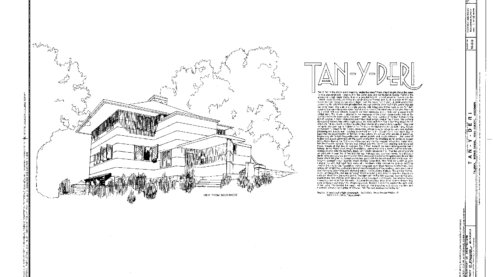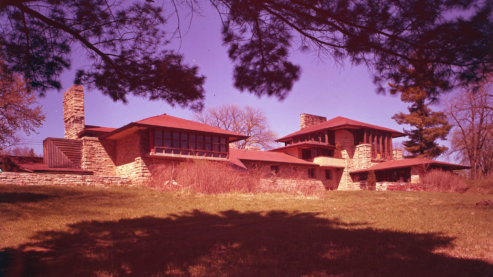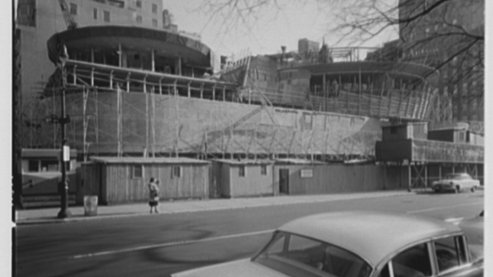Wright at the Time

After a period of self-imposed exile with Mamah Cheney in Europe, the two returned to America and settled with Cheney's children in Spring Green, Wisconsin. A few years later, while Wright was away working on Chicago’s Midway Gardens, Cheney and her two children and some workmen sat down to lunch at Taliesin. The butler-handyman bolted all of Taliesin’s doors and windows, set the house on fire and bludgeoned anybody who tried to escape. Cheney and seven others died, and the house was destroyed. Wondering “why mark the spot where desolation ended and began?” Wright buried his beloved mistress in an unmarked grave.
The Weekly Home News, August 20, 1914
“Murderer of Seven: Sets Fire to Country Home of Frank Lloyd Wright Near Spring Green”
While the members of the household were at dinner, last Saturday, Julian Carlton, a negro servant, fired Frank Lloyd Wright’s bungalow, murdered seven and seriously wounded one with a hatchet and another received injuries in jumping from a window. The dead are:
Mrs. Mamah Borthwick, their son and daughter, John and Martha Cheney, aged 11 and 9 respectively; Emil Brodelle, aged 30, an architectural draftsman; Thomas Brunker, of Ridgeway, hostler; Ernest Weston, 13-year-old son of Mr. And Mrs. Wm. Weston of Spring Green; and David Lindblom, gardener.
The wounded are: William H. Weston of Spring Green, foreman of the bungalow activities, and Herbert Fritz of Chicago. The latter escaped the negro’s wrath but received a broken arm and glass cuts in making his escape through a window. He was also slightly burned.
Mr. Wright was in Chicago, where business had called him several days before and he escaped the murders hatchet.
The negro waiter had served dinner to the men in the small room temporarily used for that purpose and to Mrs. Borthwick and her children on the dining porch, which was located just off the guest room where the child’s room had been. While they were eating he came to the door and asked Mr. Weston for gasoline, with which to clean a rug, and was given permission to get some. Soon after, those in the dining room heard a splash against the door and in an instant the room was full of flaming gasoline, which the fiend had poured against and under the door. As they attempted to escape, some through the door and some through a window, the negro struck them down with a hatchet.
Mr. Fritz was the first out. He says that he and Mr. Brodelle were eating at a separate table, and as the room burst into flames he sprang for the window and made his escape, getting out before the murderer was prepared.
Mr. Fritz was followed through the window which was about five feet from the ground, by Mr. Brodelle and Wm. Weston in the order named. As the two latter came through they were hatchted. Fritz says he saw Brodelle staggering about and saw the negro strike Weston. The other occupants of the dining room, he says, got out through the door, which was just beside the window.
Mr. Weston said that as he came through the window Carlton struck him with the hatchet and he fell. He got up and ran across the court to the studio. Carlton followed him and struck him a second time, knocking him down. Probably thinking him dead the negro went back to the slaughter. Mr. Weston then ran out another way and found David Lindblom wounded and burning. He helped him extinguish his burning clothing and together they ran to the Rieder home half a mile away and telephoned for help.
Above are the stories of the only survivors of the tragedy...
The Famous Bungalow The country home, the scene of the terrible tragedy, was a typical Wright creation built some three years ago as a retreat for a man and woman of unconventional ideas and is located on a hill just across the river directly south of Spring Green.
It is a long, low structure, carved into the brow of the hill. On three sides the building bounds an oblong court. The fourth side is a terrace joining the bungalow tot he hill upon the side of which it slings. At one end of another adjoining court are the granary, stables and men’s sleeping rooms; then, at right angles and connecting the two ends, is that part which contained offices, studio and an open loggia. Then comes the portion, near the entrance to the court, built for Mr. Wright’s mother, which was being temporarily used as a dining room by the workmen and draftsmen. Adjoining this dwelling, Mr. Wright himself lived. All this portion is completely burned. Mr. Wright will start at once to rebuild.
Frank Lloyd Wright To His Neighbors
To My Neighbors:
To you who have rallied so bravely and well to our assistance—to you who have been invariably kind to us all—I would say something to defend a brave and lovely woman from the pestilential touch of stories made by the press for the man in the street, even now, with the loyal fellows lying dead beside her, any one of whom would have given his life to defend her. I cannot bear to leave unsaid things that might brighten memory of her in the mind of anyone. But they must be left unsaid. I am thankful to all who showed her kindness or courtesy and that means many. No community anywhere could have received the trying circumstances of her life among you in a more high-minded way. I believe at no time has anything been shown her as she moved in your midst but courtesy and sympathy. This she won for herself by her innate dignity and gentleness of character but another—perhaps any other community—would have seen her through the eyes of the press that even now insists upon decorating her death with the fact, first and foremost, that she was once another man’s wife, “a wife who left her children.” That must not be forgotten in this man-made world. A wife still is “property.” And yet the well-known fact that another bears the name and title she once bore had no significance. The birds of prey were loosed upon her in death as well as in life, to fee that Moloch of the heart that maintains itself at the cost of “the man in the street,” by preaching to him in vulgar language the Gospel of Mediocrity. But this noble woman had a soul that belonged to her alone—that valued womanhood above wifehood or motherhood. A woman with a capacity for love and life made really by a higher ideal of truth, a finer courage, a higher more difficult ideal of the white flame of chastity than was “moral” or expedient and for which she was compelled to crucify all that society holds sacred and essential—in name!
And finally, out of the mass of lies which forms the article covering this catastrophe in Sunday’s Chicago Tribune, is a lie the work of an assassin that in malice belongs with the mad black except that he struck tin the heat of madness and this assassin strikes the living and the dead in cool malice.
In our life together there has been no thought of secrecy except to protect others from the contaminating stories of newspaper scandal; no pretense of a condition that did not exist. We have lived frankly and sincerely as we believed and we have tried to help others to live their lives according to their ideals.
Neither of us expected to relinquish a potent influence in our children’s lives for good—nor have we. Our children have lacked the atmosphere of an ideal love between father and mother—nothing else that could further their development. How many children have more in the conventional home? Mamah’s children were with her when she died. They have been with her every summer. She felt that she did more for her children in holding high above them the womanhood of their mother than by sacrificing it to them. And in her life, the tragedy was that it became necessary to choose the one or the other.
The circumstances before and after we came here to live among you have all been falsified and vulgarized—it is no use now to try to set them straight—but there was none of the cheap deception the evading of consequences that mark writhings from the obligations of the matrimonial trap.
Nor did Mamah ever intend to devote her life to theories or doctrines. She loved Ellen Key as everyone does who know her. Only true love is free love—no other kind is or ever can be fee. The “freedom” in which we joined was infinitely more difficult than any conformity with customs could have been. Few will ever venture it. It is not lives lived on this plane that menace the well-being of society. No, they can only serve to ennoble it.
It has sometimes been a source of annoyance to Mamah that one or two friends to whom she occasionally wrote persisted in reading a meaning between her lines that convicted her of an endeavor to seem happy, when they thought she ought not to be. I suppose when we live safe in the “heart of the block” we yearn to feel that in another situation than our—in circumstances we fail to understand—there must be unhappiness, or in circumstances of which we disapprove—an “EXPIATION.” This is peculiarly “Christian.”
Mamah and I have had our struggles, our differences, our moments of jealous fear for our ideals of each other—they are not lacking in any close human relationships—but they served only to bind us more closely together. We were more than merely happy even when momentarily miserable. And she was true as only a woman who loves know the meaning of the word. Her soul has entered me and it shall not be lost.
You wives with your certificates for loving—pray that you may love as much and be loved as well as was Mamah Borthwick! You mothers and fathers with daughters—be satisfied if what life you have invested in them works itself out upon as high a plane as it has done in the life of this lovely woman. She was struck down by a tragedy that hangs by the slender thread of reason over the lives of all, a thread which may snap at any time in any home with consequences as disastrous.
And I would urge you upon young and old alike that “Nature knows neither Past nor Future—the Present is her Eternity.” Unless we realize that brave truth there will come a bitter time when the thought of how much more potent with love and action that precious “Present” might have been, will desolate our hearts.
She is dead. I have buried her in the little Chapel burying ground of my people—beside the little son of my sister, a beautiful boy of ten, who loved her and whom she loved much—and while the place where she live with me is a charred and blackened ruin, the little things of our daily life gone, I shall replace it all little by little as nearly as it may be done. I shall set it all up again for the spirit of the mortals that lived in it and loved it—will live in it still. My home will still be there.
Frank Lloyd Wright

Excerpt from An Autobiography
By Frank Lloyd Wright
When family-life in Oak Park that spring of 1909 conspired against the freedom to which I had come to feel every soul was entitled, I had no choice, would I keep my self respect, but go out a voluntary exile into the uncharted and unknown. Deprived of legal protection, I got my back against the wall in this way. I meant to live if I could an unconventional life. I turned to this hill in the Valley as my Grandfather before me had turned to America—as a hope and haven. But I was forgetful, for the time being, of Grandfather’s Isaiah. His smiting and punishment.
I wished to be part of my beloved southern Wisconsin, too. I did not want to put my small part of it out of countenance. Architecture, after all, I have learned—or before all, I should say—is no less a weaving and a fabric than the trees are. And as anyone might see, a beech tree is a beech tree. It isn’t trying to be an oak. Nor is a pine trying to be a birch, although each makes the other more beautiful when seen together.
The world had had appropriate buildings before—why not appropriate buildings now, more so than ever before? There must be some kind of house that would belong to that hill, as trees and the ledges of rock did; as Grandfather and Mother had belonged to it in their sense of it all.
© Frank Lloyd Wright Foundation




